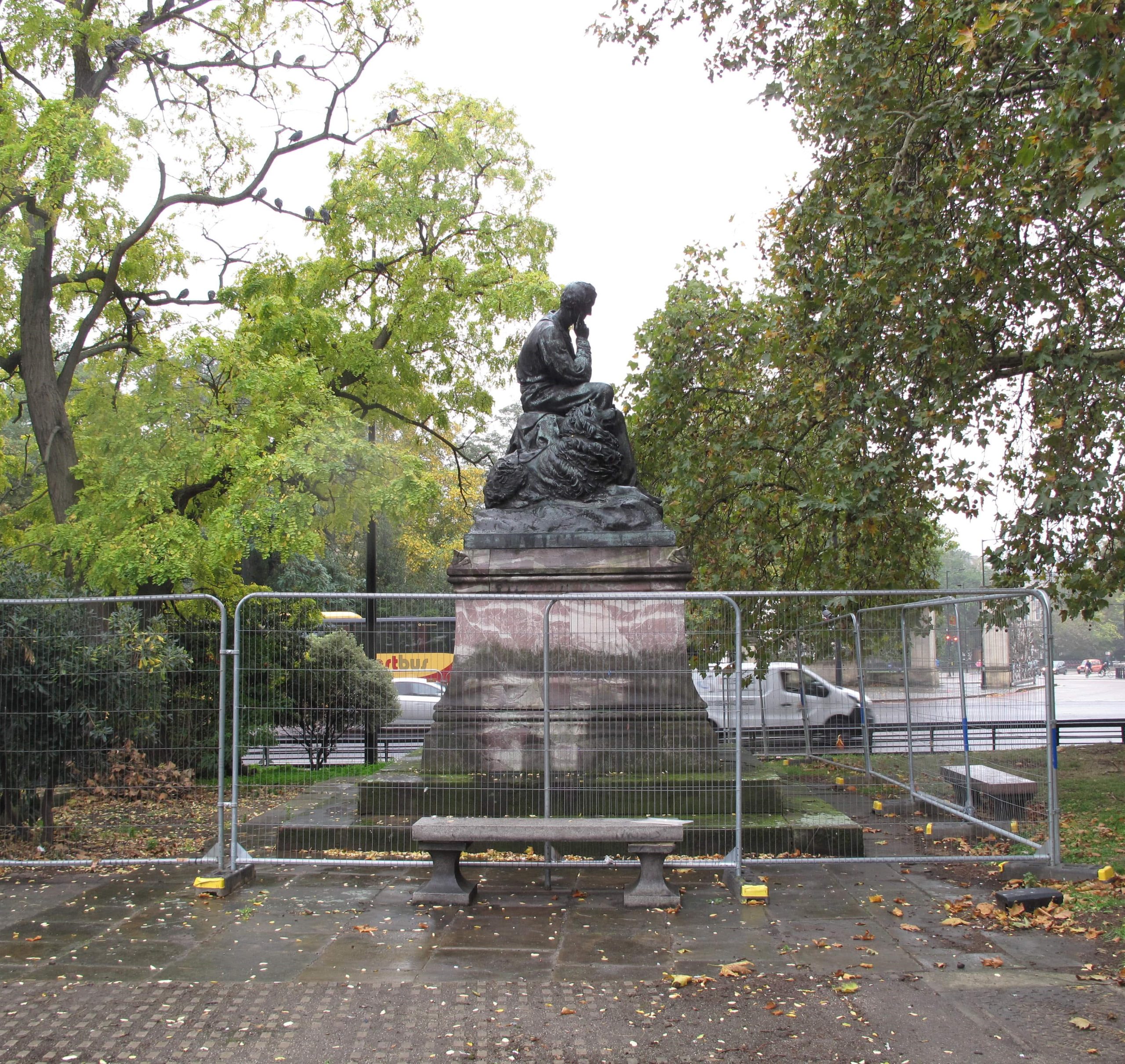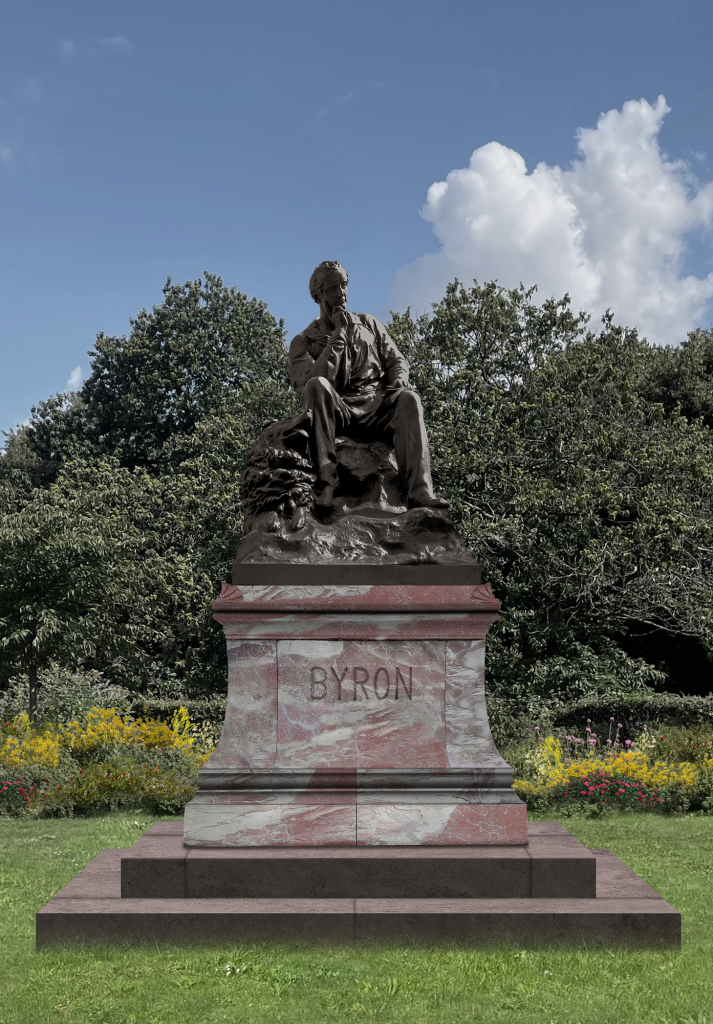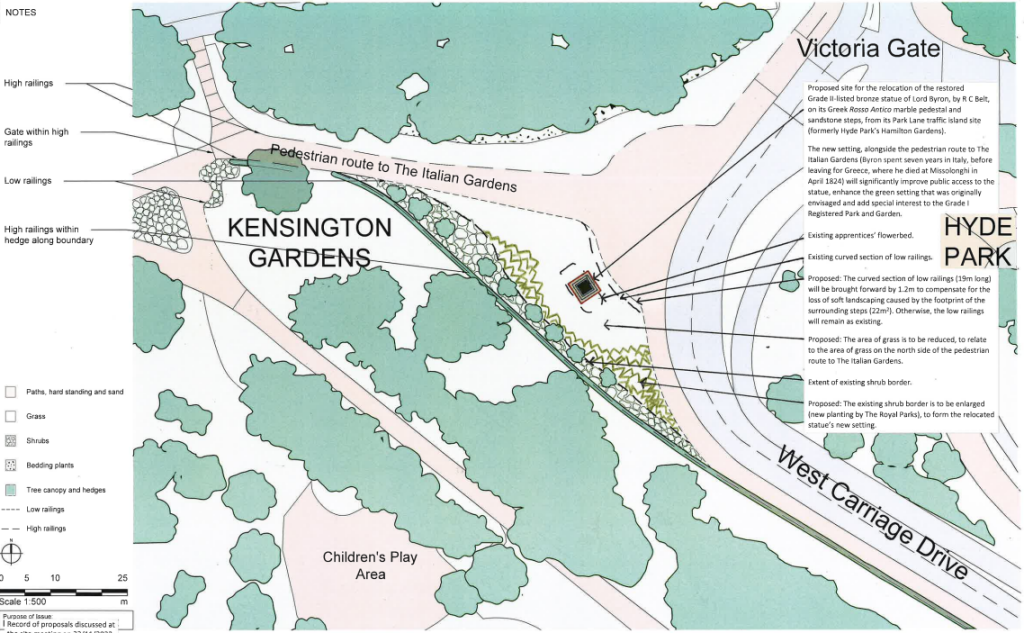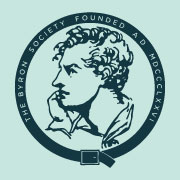TO DONATE VIA OUR JUSTGIVING PAGE CLICK HERE

As Byron enthusiasts around the world are gearing up for the bicentenary, the Byron Society in the UK has been working hard on a project to rescue one of London’s neglected and forgotten gems, the Byron Memorial Statue.
Erected in 1880, its original garden setting in Hamilton Gardens, then part of Hyde Park, gave the memorial prominence and public access. Because of changes made to the Park Lane traffic layout in the course of the 20th century, the statue is now marooned on a traffic island and all but inaccessible.
It has been waiting for a long time to be restored and relocated. This has now become a matter of urgency because it has deteriorated badly over the last fifty years and there is no maintenance regime where the statue is at present. Following a long campaign and much lobbying, the Royal Parks have offered us a new high profile location near Hyde Park’s Victoria Gate that is publicly accessible so we can all enjoy it.
The project, supported by Heritage of London Trust, forms part of the many activities around the world that will take place to commemorate the 200-year-anniversary of Lord Byron’s death at Missolonghi in Greece in April 1824. When re-sited, the Society will be promoting an educational and outreach programme linked to the statue.
We shall soon be putting in funding bids to the Heritage Lottery Fund and other charitable trusts to raise the estimated £360,000 necessary. But we also need to show that the national and international community of Byron enthusiasts is fully behind the initiative and we are hoping that everyone will make a contribution as soon as we go live on fundraising.
More on the statue
Victorian admirers of Byron, including novelists and poets like Disraeli (who became chairman of the appeal committee when Prime Minister), Tennyson, Longfellow, Wilkie Collins, Swinburne, and Matthew Arnold in addition to many other luminaries, waged a long campaign for the creation of a national memorial to Byron. Finally, after a lengthy process, their project finally came to fruition in 1880, with the Hyde Park site granted by Queen Victoria herself.
The statue is made of bronze by sculptor Richard Claude Belt (26.06.1851 – 17.11.1920), and sits on an inscribed Greek red and white marble (Rosso Antico) pedestal. It was inspired by a line from Byron’s Childe Harold’s Pilgrimage: “To sit on rocks and muse o’er flood and fell” and Byron is depicted with his beloved Newfoundland dog Boatswain (Bo’sun), at his side, a symbol for all Byron’s dogs which meant so much to him. The marble of the pedestal was a gift from the Greek Government in gratitude for Byron’s assistance to the Greeks in their struggle for independence. The pedestal is inscribed “Erected by Public Subscription”.

How the statue could look in its proposed new location
For a history of the statue see Professor Tom Mole’s recent publication, What the Victorians Made of Romanticism (Princeton University Press, 2017). Richard Edgcumbe, the chief instigator of plans for a new memorial to Byron, started modestly, considering only a marble slab over Byron’s grave in Hucknall parish church. However, once Disraeli got involved it was clear that a more ambitious plan was required.
In his History of the Byron Memorial, Edgcumbe emphasised that Disraeli wanted ‘a really national memorial’ and as Professor Mole points out there was an important democratic element to the project.
Edgcumbe explained that he could have raised sufficient funds from private donors but arranged to hold meetings in Manchester, Edinburgh, Aberdeen, Plymouth, Liverpool and Birmingham so that the whole country could “take part in the work of doing honour” to Byron.
The forthcoming bicentenary provides the perfect opportunity to restore the statue to a new position within Hyde Park. The Department for Culture (DCMS) wants to see the move take place as soon as possible. Planning permission from Westminster City Council still has to be obtained but we are hopeful that this will be forthcoming before too long. Work will commence as soon as all the planning consents have been obtained and sufficient funds have been raised.

TO DONATE VIA OUR JUSTGIVING PAGE CLICK HERE
The Byron Society (registered charity 1197293) is a charitable incorporated organisation whose objects include educating the public in and promoting knowledge of and research into the life and works of the poet Lord Byron. The society is raising funds to restore the bronze statue of the poet Lord Byron and the marble plinth on which it stands, to move the statue and plinth from its current location on a traffic island in the middle of Park Lane to a new location within Hyde Park and to provide for future conservation. An educational and outreach programme will be linked to the statue once moved. If insufficient money is raised to move the statue, or the Society is otherwise prevented from completing the move, the funds raised will be used for future maintenance and conservation of the statue and plinth in its present location. Any excess funds will be used for the charitable purposes of the Society.

